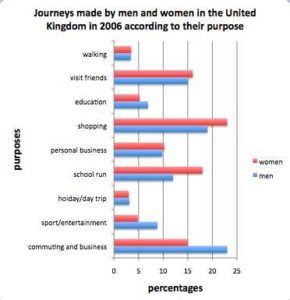Key features
We now see what the 2 key features that need to be reported are. Remember these will be the topics of our 2 content paragraphs :
- the distinction between men and women (the blue lines and the red lines)
- how certain purposes of travel are more common than others (how long the lines are)

Supporting detail: men and women
Looking at the blue and red lines this is what I see and needs to be included:
- little or no difference in “walking” “holidays” and “personal business”
- more men in “education”, “entertainment” and “commuting”
- more women in “school run”, “visiting friends” and “shopping”
- many more women in “school run” (5% difference)
- many more men in “commuting” (8% difference)
Supporting detail: purposes
This is fairly straightforward as all you need to do is arrange the different categories into an order showing the most common and least common purposes.
- commuting and shopping much the most common (around 20% average)
- visiting friends and school run both around 15% average
- personal business just under 10% average
- sport/entertainment around 7% average just more than education at 6%
- least common is walking and holidays at around 3% each
Note the % figures here are averages of the male/female numbers.
Model Answer
This bar chart shows the different reasons for making journeys in the UK in 2006 and how males and females differed in this. Overall, the main reasons for both genders to travel were for commuting and shopping,
Typically, there were few major differences between males and females. In holidays, personal business and walking both sexes took approximately the same amount of journeys, while slightly more men travelled for educational purposes and more women visited friends. Notably, almost twice as many men as women travelled for entertainment reasons and, likewise, around 7% more men commuted to work. The two areas in which women travelled significantly more than men were shopping and the school run.
The major reasons for travelling were commuting and shopping, both being around 20 per cent of trips. The next most common reasons were visiting friends and doing the school run at 15%, closely followed by personal business at around 10%. Travelling for sport and entertainment (7%) was only just more common than journeys for educational purposes (6%). Finally, the fewest number of trips were travelling for holidays and walking, both of which accounted for around 3 per cent of all journeys.

